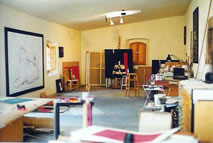|

|
|
Mediterranean
Edge
The square is a theme that occurs frequently in
my paintings. My "Cuadrado Rojo" and "Damero
Rojo" (Red Square and Red Chess board) series
in the 1990s came about as a direct consequence
of the constructivist paintings I was doing towards
the end of the ‘70s and the beginning of the
‘80s. Even in my most figurative (and expressionist)
work, the formal structure of the square is behind
most of the images. The "Anonymous Heroes"
are synthetized faces that have a quite circular
aspect, and the circle and the square which contains
it (or is contained by it) end up being the same
thing. The "Menina" is the only human
figure I know of which is square, it is as wide
as it is tall. And all of my two and three-dimensional
work on this subject center on this strange, formal
structure.
What I like most about the Menina is her archetypal
femininity. The fashions of the period, the crinoline
and matching hairstyle, transform the feminine shape
into a powerful icon, with those oversized hips
which remind us in some way of ancient fertility
goddesses. Earth mother, firmly grounded, crowning
above all other creatures.
The definition of femininity acquires an unusual
forcefulness when the base area of the figure is
equal to, or even greater than its height, (this
despite the hairstyle´s attempt to "square"
the image, aided by stylised wide-sleeved costumes
and baroque ornaments to "fill in" the
upper area). The final result is so graphically
powerful that many artists have adapted it to suit
their own style, whatever that may be. One could
even talk of a new iconography with its own original
hallmark, like still-lifes, nudes or seascapes.
From Velasquez´ Las Meninas to Malevitch
´s square – anything might happen.
The "Damero" is made up of a range of
small squares contained within one large square
to create a games board where man’s intelligence
— i.e. the very thing that makes him a rational
being- may be measured. This "game territory"
is a metaphor for real life and what one can make
of it, and the emptying out of one of these squares
into a sculpture of aluminum, which I did in 1999,
creates a perfect cubic space, symbolizing that
absolute (and therefore unattainable) truth that
the player seeks.
I have always been proud to talk of those artists
which have influenced my work, and there are a lot
of them, because I believe art is like a river,
each and every drop of water owes its being to a
previously existing source and is also a promise
of whatever follows. All artists have their points
of reference, and I am no exception. The Italian
Quattrocento, Velázquez, Goya, Vermeer, Cézanne,
German Expressionism, Russian Constructivism led
by Málevitch, the Bauhaus, Kandinsky, Mondrian,
Kahnweiler’s cubism, Picasso, Miró,
the New York School, Gorky, Rothko, de Kooning,
Rauschenberg, Oteiza, Chillida etc. These are all
points of reference common to many artists of my
generation. The thing that distinguishes one artist
from another is what we make of this information,
which is available to all of us. Also, other, more
subtle things influence us, some of them very personal
and other general influences related to our surroundings.
I believe that my work is strongly influenced by
the place I live, which is close to where I was
born. This little corner of the Mediterranean has
a very special type of light which fills everywhere
with sensual, and peculiarly beautiful, colors and
shapes. It is a place where I can be myself.
|